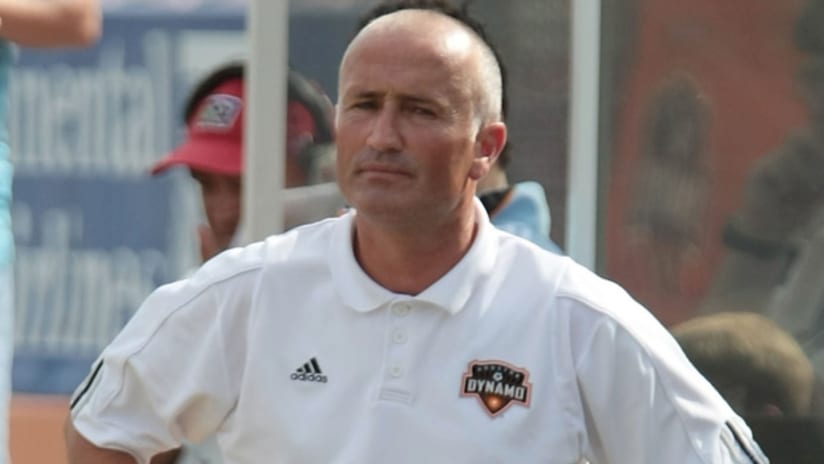When Dominic Kinnear slips out of his well-worn 4-4-2 and into something more comfortable, you know there is a darn good reason.
The Houston Dynamo manager, who has long worshiped at the altar of the 4-4-2, needed a change last week. So he lined up his side in a 4-3-3, that is, with three forwards, for the trip to the Home Depot Center last weekend. Corey Ashe and Brian Mullan stretched the Chivas USA defense to the touchlines, while Richard Mulrooney, Lovel Palmer and Brad Davis squeezed together centrally.
Mission accomplished. Houston ran out 2-0 winners.
It was the kind of mid-season change that can catch opponents unaware. Given an extra forward to deal with Saturday against Houston, Chivas USA fullbacks Mariano Trujillo and Jonathan Bornstein needed to exhibit more caution going forward initially. It took time for the Goats to work it out; by the time they did, they were behind by two goals.
Chivas USA manager Martin Vasquez has rolled out just about every possible formation to find one that works. Much of the tinkering is about getting playmaker Sacha Kljestan in the right spot. The U.S. World Cup hopeful lined up outside on the left and outside on the right in various looks (4-1-4-1, 4-4-2, 4-2-3-1, etc.). Vasquez seems to have settled (perhaps) on the current look, a 4-5-1 with Kljestan playing in behind a lone striker and ahead of two centrally aligned rookie worker bees, Blair Gavin and Ben Zemanski.
It didn’t work against Houston—historically speaking very little has ever worked for the Goats against Houston—but Chivas USA do seem more competitive now than they did earlier in the season. Vasquez is likely to stick with the current look—unless Kljestan is off to Bob Bradley’s training camp, which will mean he has to return to the chalkboard.
Kinnear’s and Vasquez’s actions prove once again that, sometimes, a little in-season tactical toggling is in order. However, it doesn’t always work.
Seattle, for instance, continue to look for the right way forward, tactically speaking. Sigi Schmid’s team has generally been in a 4-4-2—although where Freddie Ljungberg lines up alters the formation significantly. Sometimes he’s a right-sided midfielder, which usually means the two central midfielders become more defensive-minded, always available to slide over and provide cover so the fast Swede doesn’t expend so much energy on defensive toil. Other times, Ljungberg is a central attacker or a second forward, which also alters the look.
Saturday against Los Angeles, Schmid had his team doing the 4-3-3 dance, with “wingers” stationed up high and Ljungberg roaming behind the trio of forwards. Needless to say, the results weren’t pretty, although that surprising 4-0 loss for the home side was probably more about poor form and flagging effort than formations.
There is evidence that Seattle’s varying formations will become an asset before it is all over. When Bruce Arena built those terrific teams at D.C. United back in the ’90s, he liked to get his side comfortable in two formations. United could transition seamlessly between a 3-5-2 and a 4-4-2. Imagine the extra effort needed for opposing coaches, who could try to provide as much pre-game information as possible to players but were limited because they didn’t know which version of United would line up.
(Arena did the same with the 2002 World Cup team, which “based” out of a 4-4-2 but flummoxed Mexico by emerging for the critical Round-of-16 match in a 3-5-2. With Claudio Reyna stationed on the right, Mexico struggled to locate the U.S. passing and possession specialist and never truly got comfortable with the match.)
Speaking of MLS back in the day, formations sometimes get rearranged to accommodate defensive players, not just attackers. Toward the back end of Lubos Kubik’s time in MLS, his teams, Chicago and Dallas, wanted the veteran center back on the field but needed to make a few adjustments. Kubik was a smart player, but declining foot speed meant he was vulnerable in one-on-one situations. So his coaches played a 3-5-2 to leave him free, protected by two markers.
Back to present day, and the chameleon that is Preki. Toronto FC are accustomed to changes on the fly, as their coach familiarize himself with his roster’s strengths and weaknesses. His adjustments game-to-game so far seem to be about getting two players into their best roles: Dwayne De Rosario and Julian de Guzman, who also happen to be the most valuable assets at BMO.
Early on, TFC were all over the place, with De Rosario playing out wide, as a second striker or even as a lone striker in a 4-5-1. Meanwhile, de Guzman was initially assigned a role as a central attacking midfielder.
It obviously didn’t work very well. So all that seems set to be forgotten. TFC seem best in a pretty ordinary 4-4-2, with de Guzman alongside a man with some midfield bite. Compared to the version of 4-4-2 Preki preferred at Chivias USA, this one looks a little different, sporting a pair of two-way central midfielders. At Chivas USA last year, Preki preferred a pair of defensive midfielders with the attacking mustard poured on from the outside.
Still, considering the Reds’ 4-1 thumping of Chicago, it looks like Preki may have landed on the right square with his 4-4-2—until the next mid-stream formation change, that is.
Steve Davis writes about Major League Soccer and the U.S. game for MLSSoccer.com, SI.com and at his blog Daily Soccer Fix.


